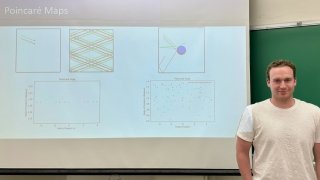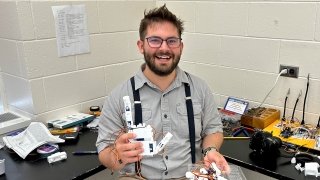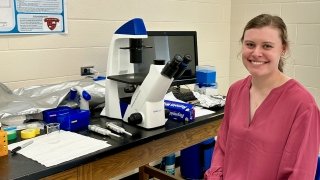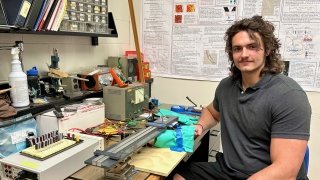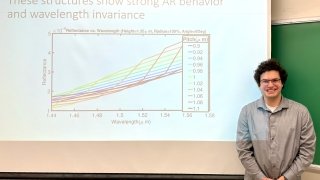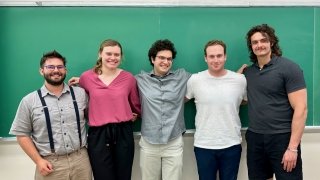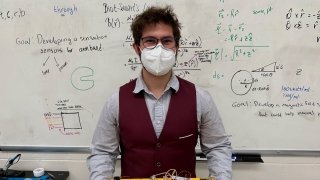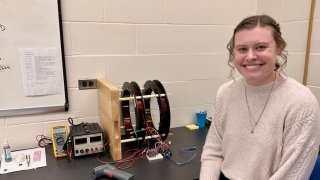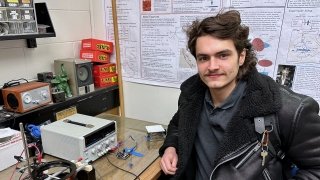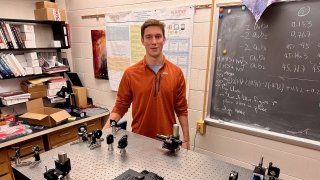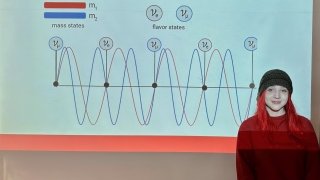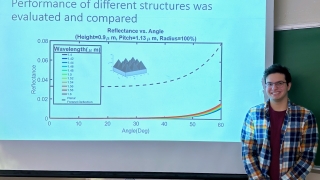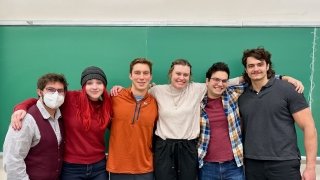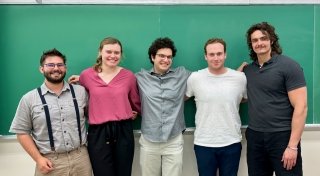
Senior Research Projects 2022 - 2023
Seniors present to the physics department the results of their Phys 489/490: SYE Advanced Laboratory and Phys 499: Honors SYE research projects at the end of each semester. The abstracts for their research are below and photos of the student presenters follow afterwards:
Spring 2023
Chaotic Motion of Conservative Systems - Maximilian Arnone '23
Contrary to periodic motion, which is characterized by being self-repeating, having the ability to measure time from a later state, and returning to a specific position with the same velocity, chaotic motion is defined by its irregularity and unpredictability. Such unpredictability is due to the sensitivity of the system’s initial conditions. Small changes in initial conditions lead to dramatic differences over time, which makes predicting the long-term behavior of a chaotic system difficult. Chaotic motion can also be described mathematically using Lyapunov exponents. The maximal Lyapunov exponent describes the degree of chaos within a system by measuring the speed at which the paths of trajectories with infinitesimally similar initial conditions diverge from one another. The discovery of the concept of chaos theory is tied directly to physical applications, notably weather forecasting. Through a simplified model of atmospheric convection consisting of three coupled differential equations, Edward Lorenz discovered the presence of a strange attractor within the system. What would come to be known as the Lorenz attractor described the behavior of the system over time while exhibiting selfsimilar patterns and a sensitivity to initial conditions which resulted in vastly different later outcomes. This challenged the notion that small changes in initial conditions led to equally small differences in outcomes as well as showed that simple, deterministic systems could exhibit complex and unpredictable behavior.
The goal of my research is to explore the theoretical aspects of chaotic motion, with a focus on the simulation and graphical representation of chaotic billiards, specifically the Sinai billiard. The Sinai billiard is a system consisting of a point particle moving throughout a region defined as a polygonal boundary with a disc placed within, in order to induce scattering of the projectile.
For more information, contact Dr. Cristian Armendariz-Picon
Improving the Functionality of Low-Cost Prosthetic Designs - Cameron J. Brochu '23
Within the lower price range of prosthetic devices, there is a significant lack of mechanical functionality. Many existing prosthetic devices in this cost range are designed to function without using motors, relying only on the residual limbs of the users and some even lack basic motion capabilities. This work aims to create a low-cost prosthetic that provides similar capabilities to that of the human hand. Building upon the prosthetic designs published by the e-NABLE group, our design aims to enhance the current motion capabilities. Additionally, we prioritize the use of low cost materials to ensure that the final design remains affordable with a target cost of under $500.
For more information, contact Dr. Massooma Pirbhai or Dr. Joe Erlichman
Developing a Safe Magnetic Field Exposure System for in Vitro Analysis of Neural Cells - Cora Ferguson '23
Blood vessels in the brain provide oxygen and nutrients to neurons, which are responsible for maintaining homeostasis and controlling cognitive behavior. The rupture or blockage of these blood vessels prevents oxygen from reaching neurons, resulting in neuronal death and disruption of vital functions, as commonly observed in strokes. Due to the unique damage footprint of every stroke, there is an increasing demand for individualized therapeutic tools to improve cognitive and motor regeneration during stroke recovery. One such therapy is to use externally applied magnetic fields that are painless and highly tunable. Intracellular electromagnetic fields (EMFs) play a role in the movement of ions, regulation of genes, and energy generation within neurons. Studies have shown that adding externally applied magnetic fields can modulate intracellular EMFs, leading to increased proliferation and metabolic activity in neural cells. In this study, HT22 neuronal cells were exposed to a static 1 mT magnetic field to analyze the effects of short-term therapeutic exposure on neural proliferation, growth rates, and cell morphology. Magnetic field exposure significantly increased the growth and proliferation of HT22 cells and decreased circularity compared to control conditions. These metrics are associated with increased neural activity and motivate future research on magnetic fields for stroke rehabilitation.
For more information, contact Dr. Massooma Pirbhai or Dr. Ana Estevez
Exploring Efficient Rail Gun Designs - Austin Galli '23
A rail gun is a device that launches projectile through the use of electromagnetic force. One of the main focuses of my research was to mathematically model the behavior of a rail gun, so I can design an optimally efficient system. The parameters of the mathematical model can be evaluated to assess which values need to be altered in order to maximize the final momentum of the projectile. I verified the accuracy of both of these equations through a series of experiments involving measuring voltage, magnetic field, and projectile acceleration. Multiple prototype rail guns were used to establish that the theoretical model exhibited the same behavior as the physical prototype model. Results using the most recent physical prototype were inconclusive.
For more information, contact Dr. Cristian Armendariz-Picon or Dr. Catherine Jahncke
Computational Exploration of Anti-Reflective Nanostructures - Ganesh Petterson '23
Anti-reflective (AR) coatings and structures are a key part of many optical systems, providing increased transmission efficiency and reducing issues related to back-reflection and unwanted interference. However, the theory behind these devices means they often function best at specific wavelengths and incidence angles, leading to difficulties when reflection needs to be minimized over a broadband spectrum or wide angular range. This project uses the GD-Calc MATLAB package to computationally explore the design of AR nanostructures, periodic patterns of sub-wavelength structures designed to create a gradient in the effective refractive index. Baseline construction parameters are determined from previous work in the literature, manufacturing feasibility is considered when determining final structure parameters, and structure performance is evaluated based on overall transmittance as well as sensitivity to small parameter variations. We optimize structures such as cones, cylinders, and pyramids to perform under 1550 nm light for a variety of incidence angles. Pyramids show the best reflection reduction, with reflectance on the order of 10−7 at normal incidence, staying below 10−3 up to an incidence angle of roughly 40 degrees. Cones and cylinders show similar behaviour, albeit with higher values. Overall, we have designed several structures with strong AR behavior over a wide angle range.
For more information, contact Dr. Catherine Jahncke
Fall 2022
Sensation Capabilities for Prosthetics - Cameron J. Brochu '23
Most prosthetic devices either lack human abilities such as sensation and movement or are too expensive for the general consumer. This work aims to bridge the gap by focusing on the development of low-cost alternatives to advanced sensation systems in prosthetic designs. Our design mimics the human body’s own response systems and builds upon the work published by John Hopkins University in Osborn et al. who developed a rubber skin that allowed for pain and touch sensation to be felt by a prosthetics user. Our work advances their design by having temperature sensor and feedback capabilities along with a touch sensor and feedback system. In addition to developing a sensor system, we focused on only using low-cost materials to create the circuit, costing around $300 dollars compared to much more expensive prosthetic counterparts.
For more information, contact Dr. Massooma Pirbhai or Dr. Joe Erlichman
Developing a Safe Magnetic Field Exposure System for in Vitro Analysis of Neural Cells - Cora Ferguson '23
Magnetic fields are important in ion movement, regulating different genes, and generating energy within cells. However, when the balance of these systems is disrupted by environmental changes, it causes cellular damage and/or death. This is observed during strokes, when blood clots get lodged in blood vessels that feed oxygen to neurons in the brain. Without oxygen, neurons die, consequently severing the connections that control functions vital to life. Due to the unique damage footprint of every stroke, there is an increasing demand for individualized therapeutic tools to improve cognitive and motor regeneration during stroke recovery. Externally applied magnetic fields serve as a viable therapeutic technology as they are painless, adjustable, and have been previously demonstrated to promote cellular growth and survival. In this study, a magnetic field exposure system is developed using Helmholtz coils and an Arduino-based environmental monitoring system. HT22 neural cells were used to assess the safety of 30 minute exposure to a static 1mT magnetic field using this system. Preliminary results show that the magnetic field exposure under these conditions does not hinder cellular growth which motivates the continuation of this project using C17.2 neural stem cells.
For more information, contact Dr. Massooma Pirbhai or Dr. Ana Estevez
Exploring Efficient Rail Gun Designs - Austin Galli '23
A rail gun is a device that launches projectile through the use of electromagnetic force. One of the main focuses of my research was to mathematically model the behavior of a rail gun, so I can design an optimally efficient system. The parameters of the mathematical model can be evaluated to assess which values need to be altered in order to maximize the final momentum of the projectile. I verified the accuracy of some of these equations through a series of experimentation using a prototype rail gun to establish if the theoretical model exhibited the same behavior as the physical prototype model.
For more information, contact Dr. Cristian Armendariz-Picon
Bell’s Inequality and The Grangier Experiment - Ben Heinze '23
Entangled particles demonstrate non-local behaviors and correlations which have been shown to have many applications. Current research has shown that entangled photons can be used to analyze biological materials and chemicals such as DNA and brain tissue samples. Bell Inequalities are inequalities derived under the assumption of locality, which quantum mechanics predicts violations of. To demonstrate that particles are entangled, a Bell Inequality is violated. In this case, the Bell Inequality tested was the CHSH inequality. The Grangier experiment, which has been used to demonstrate the existence of photons, does not utilize entanglement. However, it utilizes a similar apparatus to one utilized by modern researchers using entangled photons. The CHSH inequality was violated using a pair of photons with S = 2.290 ± 0.009, which implies that the pairs of photons were entangled. In completing the Grangier experiment, it was found that 𝑔(2)(0) = 0.19 ± 0.08 for the antibunched light source, which implies that photons exist. By violating the CHSH inequality and finding results that agree with past results for the Grangier experiment, the presence of entangled photons and the proper function of the Grangier apparatus has been demonstrated. Along with entangled photons, current research utilizes an apparatus similar to the one used in the Grangier experiment, so the work done this semester has laid the groundwork for building upon this research.
For more information, contact Dr. Munir Pirbhai
Evaluating the Effectiveness of the Chi-Square Test at Determining the Neutrino Mass Ordering - Brenna McConnell '23
The purpose of this work is to examine the ability of the chi-square test at determining the correct mass ordering for neutrinos. Poisson distributions parented from the normal ordering theory were used as estimations of experimental data that could be obtained if the normal ordering theory was correct. The chi-square test was then used to compare the simulated distribution to the theoretical distributions for both the normal and inverted ordering theories. The effectiveness of the chi-square was measured in how significantly the test indicated that the simulated distributions were not parented from the inverted ordering theory. Results showed that the resulting chi-square value for the inverted ordering theory had a p-value of 4.6 ×10−5 which is not significant enough to reject the inverted ordering as a plausible theory. Therefore, the application of another statistical test may be helpful in reaching increased statistical significance with the same amount of data.
For more information, contact Dr. Munir Pirbhai
Computational Exploration of Anti-Reflective Nanostructures - Ganesh Petterson '23
Anti-reflective (AR) coatings and structures are a key part of many optical systems, providing increased transmission efficiency and reducing issues related to back-reflection and unwanted interference. However, the theory behind these devices means they often function best at specific wavelengths and incidence angles, leading to difficulties when reflection needs to be minimized over a broadband spectrum or wide angular range. This project uses the GD-Calc MATLAB package to computationally explore the design of AR nanostructures, periodic patterns of sub-wavelength structures designed to create a gradient in the effective refractive index. Baseline construction parameters are determined from previous work in the literature, manufacturing feasibility is considered when determining final structure parameters, and structure performance is evaluated based on overall transmittance as well as sensitivity to small parameter variations. We optimize structures such as cones, cylinders, and pyramids to perform under 1550 nm light for a variety of incidence angles. Pyramids show the best reflection reduction, with reflectance on the order of 10−7 at normal incidence, staying below 10−3 up to an incidence angle of roughly 40 degrees. Cones and cylinders show similar behaviour, albeit with higher values. Overall, we have designed several structures with strong AR behavior over a wide angle range.
For more information, contact Dr. Catherine Jahncke

